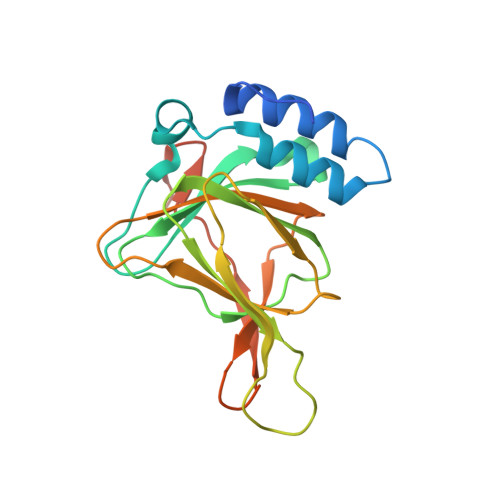An Insight into the Mechanism of Human Cysteine Dioxygenase: KEY ROLES OF THE THIOETHER-BONDED TYROSINE-CYSTEINE COFACTOR.
Ye, S., Wu, X., Wei, L., Tang, D., Sun, P., Bartlam, M., Rao, Z.(2007) J Biol Chem 282: 3391-3402
- PubMed: 17135237
- DOI: https://doi.org/10.1074/jbc.M609337200
- Primary Citation of Related Structures:
2IC1 - PubMed Abstract:
Cysteine dioxygenase is a non-heme mononuclear iron metalloenzyme that catalyzes the oxidation of cysteine to cysteine sulfinic acid with addition of molecular dioxygen. This irreversible oxidative catabolism of cysteine initiates several important metabolic pathways related to diverse sulfurate compounds. Cysteine dioxygenase is therefore very important for maintaining the proper hepatic concentration of intracellular free cysteine. Mechanisms for mouse and rat cysteine dioxygenases have recently been reported based on their crystal structures in the absence of substrates, although there is still a lack of direct evidence. Here we report the first crystal structure of human cysteine dioxygenase in complex with its substrate L-cysteine to 2.7A, together with enzymatic activity and metal content assays of several single point mutants. Our results provide an insight into a new mechanism of cysteine thiol dioxygenation catalyzed by cysteine dioxygenase, which is tightly associated with a thioether-bonded tyrosine-cysteine cofactor involving Tyr-157 and Cys-93. This cross-linked protein-derived cofactor plays several key roles different from those in galactose oxidase. This report provides a new potential target for therapy of diseases related to human cysteine dioxygenase, including neurodegenerative and autoimmune diseases.
Organizational Affiliation:
Tsinghua-IBP Joint Research Group for Structural Biology, Tsinghua University, Beijing 100084, China.
















